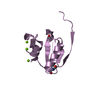[English] 日本語
 Yorodumi
Yorodumi- PDB-2kvs: NMR Solution Structure of Q7A1E8 protein from Staphylococcus aure... -
+ Open data
Open data
- Basic information
Basic information
| Entry | Database: PDB / ID: 2kvs | ||||||
|---|---|---|---|---|---|---|---|
| Title | NMR Solution Structure of Q7A1E8 protein from Staphylococcus aureus: Northeast Structural Genomics Consortium target: ZR215 | ||||||
 Components Components | Uncharacterized protein MW0776 | ||||||
 Keywords Keywords | STRUCTURAL GENOMICS / UNKNOWN FUNCTION / PSI-2 / NESG / BIG target / Protein Structure Initiative / Northeast Structural Genomics Consortium | ||||||
| Function / homology | YozE SAM-like / YozE SAM-like domain / YozE SAM-like superfamily / YozE SAM-like fold / DNA polymerase; domain 1 / Orthogonal Bundle / Mainly Alpha / YozE SAM-like domain-containing protein / YozE_SAM_like domain-containing protein Function and homology information Function and homology information | ||||||
| Biological species |  | ||||||
| Method | SOLUTION NMR / simulated annealing | ||||||
| Model details | lowest energy, model 1 | ||||||
 Authors Authors | Swapna, G.V.T. / Montelione, A.F. / Wang, D. / Ciccosanti, C. / Janjua, H. / Xiao, R. / Acton, T.B. / Rost, B. / Everett, J. / Montelione, G.T. / Northeast Structural Genomics Consortium (NESG) | ||||||
 Citation Citation |  Journal: To be Published Journal: To be PublishedTitle: NMR Solution Structure of Q7A1E8 protein from Staphylococcus aureus: Northeast Structural Genomics Consortium target: ZR215 Authors: Swapna, G.V.T. / Montelione, A.F. / Wang, D. / Ciccosanti, C. / Janjua, H. / Xiao, R. / Acton, T.B. / Rost, B. / Everett, J. / Montelione, G.T. | ||||||
| History |
|
- Structure visualization
Structure visualization
| Structure viewer | Molecule:  Molmil Molmil Jmol/JSmol Jmol/JSmol |
|---|
- Downloads & links
Downloads & links
- Download
Download
| PDBx/mmCIF format |  2kvs.cif.gz 2kvs.cif.gz | 557.3 KB | Display |  PDBx/mmCIF format PDBx/mmCIF format |
|---|---|---|---|---|
| PDB format |  pdb2kvs.ent.gz pdb2kvs.ent.gz | 471.5 KB | Display |  PDB format PDB format |
| PDBx/mmJSON format |  2kvs.json.gz 2kvs.json.gz | Tree view |  PDBx/mmJSON format PDBx/mmJSON format | |
| Others |  Other downloads Other downloads |
-Validation report
| Summary document |  2kvs_validation.pdf.gz 2kvs_validation.pdf.gz | 465.4 KB | Display |  wwPDB validaton report wwPDB validaton report |
|---|---|---|---|---|
| Full document |  2kvs_full_validation.pdf.gz 2kvs_full_validation.pdf.gz | 614.3 KB | Display | |
| Data in XML |  2kvs_validation.xml.gz 2kvs_validation.xml.gz | 35.8 KB | Display | |
| Data in CIF |  2kvs_validation.cif.gz 2kvs_validation.cif.gz | 48.7 KB | Display | |
| Arichive directory |  https://data.pdbj.org/pub/pdb/validation_reports/kv/2kvs https://data.pdbj.org/pub/pdb/validation_reports/kv/2kvs ftp://data.pdbj.org/pub/pdb/validation_reports/kv/2kvs ftp://data.pdbj.org/pub/pdb/validation_reports/kv/2kvs | HTTPS FTP |
-Related structure data
| Similar structure data | |
|---|---|
| Other databases |
- Links
Links
- Assembly
Assembly
| Deposited unit | 
| |||||||||
|---|---|---|---|---|---|---|---|---|---|---|
| 1 |
| |||||||||
| NMR ensembles |
|
- Components
Components
| #1: Protein | Mass: 9452.560 Da / Num. of mol.: 1 Source method: isolated from a genetically manipulated source Source: (gene. exp.)   |
|---|
-Experimental details
-Experiment
| Experiment | Method: SOLUTION NMR / Details: PSI-2 BIG | ||||||||||||||||||||||||||||||||||||||||||||||||
|---|---|---|---|---|---|---|---|---|---|---|---|---|---|---|---|---|---|---|---|---|---|---|---|---|---|---|---|---|---|---|---|---|---|---|---|---|---|---|---|---|---|---|---|---|---|---|---|---|---|
| NMR experiment |
| ||||||||||||||||||||||||||||||||||||||||||||||||
| NMR details | Text: The structure was determined using triple resonance NMR spectroscopy. Automated resonance assignments were made using AutoAssign. Sidechain assignments were completed manually. Chemical shift ...Text: The structure was determined using triple resonance NMR spectroscopy. Automated resonance assignments were made using AutoAssign. Sidechain assignments were completed manually. Chemical shift assignments were validated using AVS software. Automated NOESY assignments were made using AutoStructure and structure solution was determined using CYANA-2.1. |
- Sample preparation
Sample preparation
| Details | Contents: 0.71 mM [U-100% 13C; U-100% 15N] ZR215-1, 90% H2O/10% D2O Solvent system: 90% H2O/10% D2O |
|---|---|
| Sample | Conc.: 0.71 mM / Component: ZR215-1 / Isotopic labeling: [U-100% 13C; U-100% 15N] |
| Sample conditions | Ionic strength: 100mM NaCl / pH: 7.5 / Pressure: ambient / Temperature: 293 K |
-NMR measurement
| NMR spectrometer |
|
|---|
- Processing
Processing
| NMR software |
| ||||||||||||||||||||||||||||||||||||||||||||||||||||||||||||
|---|---|---|---|---|---|---|---|---|---|---|---|---|---|---|---|---|---|---|---|---|---|---|---|---|---|---|---|---|---|---|---|---|---|---|---|---|---|---|---|---|---|---|---|---|---|---|---|---|---|---|---|---|---|---|---|---|---|---|---|---|---|
| Refinement | Method: simulated annealing / Software ordinal: 1 Details: 400 structures were calculated and 20 best conformers were then refined in a shell of water using CNS. Initial dihedral angle constriants were obtained from TALOS. Final quality factors ...Details: 400 structures were calculated and 20 best conformers were then refined in a shell of water using CNS. Initial dihedral angle constriants were obtained from TALOS. Final quality factors determined using PSVS software. Ordered residues were defined as 8-12,18-30,35-37,43-77.RMSD(ordered residues):Backbone 1.0A, All atoms 1.5A; Ramachandran statistics for all ordered regions: Most favored regions: 91.5%; Additionally allowed: 8.4% and generously allowed: 0.1%. Procheck scores for all ordered residues are (Raw/Z): phi-psi 0.11/0.75 All:0.04/0.24; MolProbity clash score(Raw/Z):13.45/-0.78; RPF scores for goodness of fit of NOESY data: Recall: 0.954; Precision:0.928; F-measure: 0.941; DP-score 0.798. | ||||||||||||||||||||||||||||||||||||||||||||||||||||||||||||
| NMR constraints | NOE constraints total: 971 / NOE intraresidue total count: 93 / NOE long range total count: 199 / NOE medium range total count: 378 / NOE sequential total count: 301 | ||||||||||||||||||||||||||||||||||||||||||||||||||||||||||||
| NMR representative | Selection criteria: lowest energy | ||||||||||||||||||||||||||||||||||||||||||||||||||||||||||||
| NMR ensemble | Conformer selection criteria: structures with the lowest energy Conformers calculated total number: 400 / Conformers submitted total number: 20 / Maximum upper distance constraint violation: 3.39 Å | ||||||||||||||||||||||||||||||||||||||||||||||||||||||||||||
| NMR ensemble rms | Distance rms dev: 0.06 Å |
 Movie
Movie Controller
Controller












 PDBj
PDBj HSQC
HSQC